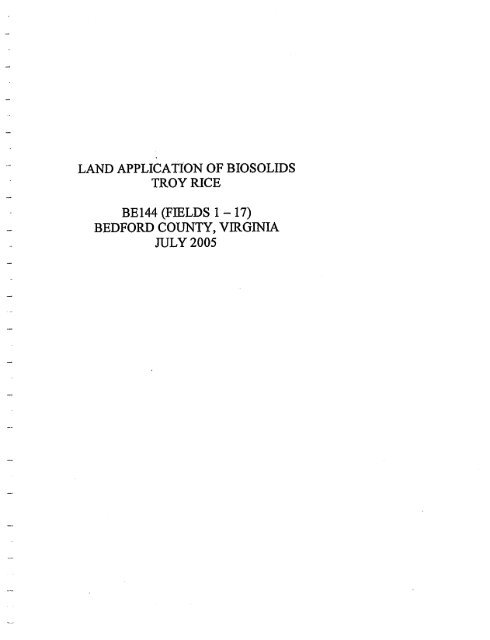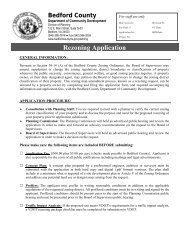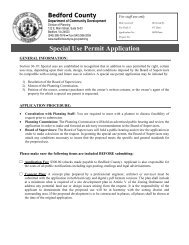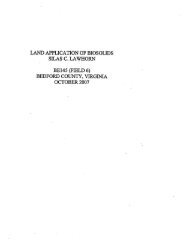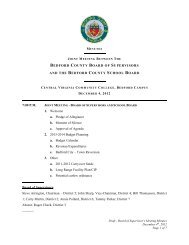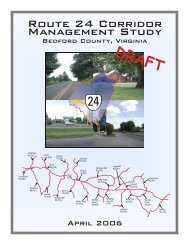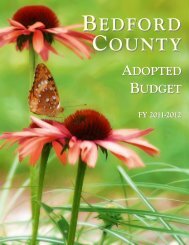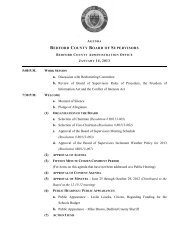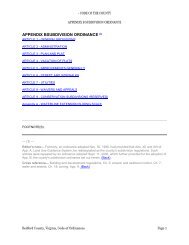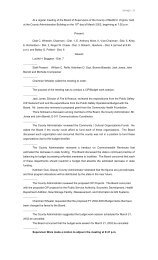land application of biosolids be144 (fields 1 - 17) bedford county ...
land application of biosolids be144 (fields 1 - 17) bedford county ...
land application of biosolids be144 (fields 1 - 17) bedford county ...
Create successful ePaper yourself
Turn your PDF publications into a flip-book with our unique Google optimized e-Paper software.
LAND APPLICATION OF BIOSOLIDSTROY RICEBE144 (FIELDS 1 - <strong>17</strong>)BEDFORD COUNTY, VIRGINIAJULY 2005
88 SYNAGROA Residuals Management CompanyJuly 1,2005Dr. Cal M. SawyerDirector, Division <strong>of</strong> Wastewater EngineeringVirginia Department <strong>of</strong> HealthPO Box 2448Richmond, VA 23218Dear Dr. Sawyer:Transmitted herein for your consideration is <strong>land</strong> <strong>application</strong> site for Troy Rice (designated asBE 144 <strong>fields</strong> 1-<strong>17</strong>) located in Bedford County, Virginia. This submission contains strictly sitespecificinformation. Please refer to the operations and maintenance manual submitted underseparate cover for all non-site specific information.Do not hesitate to contact me at (804) 433-2<strong>17</strong>0 should you have any questions or requireadditional information.Sincerely,J 0.D. Steve McMahonTechnical Services DirectorDSM/cmwEnclosuresSynagro Mid-Atlantic, Inc.10647 Tidewater Trail, Champlain, VA 22438 • Ph: (804)443-2<strong>17</strong>0 ♦ Fax (804)443-2214
mSYNAGRQA Ii.cs/sJ/u//sMs/m/gen/cut Comht/nyFIELD SUMMARY SHEETTroy RiceBE144
IMPORTANT INFORMATION ABOUT USING BIOSOLIDS AS A FERTILIZERBiosolids Generation,reated solids that are separated from Water during the wastewater treatmentf Bos^ds^nTproduced by public and private wastewater treatment plants (Generators) The Generator issiblefo?su?^!ng <strong>biosolids</strong> that are suitable for <strong>land</strong> <strong>application</strong> according to state and federal specifications.Sf^i^rnSSnLaen in a form that can be taken up by plants during their growth cycle.nhfMsnhnnis to the soilBiosolids also addIf lime is added to <strong>biosolids</strong>, the <strong>biosolids</strong> will have the added benefit ot a liming agent.Biosolids^contain many primary, secondary and micronutrients that can be used by plants.Biosolids are primarily anorganic material; when added to soil, they improve water and nutrient retention, reduce erosion potential andImprove soil structure.S^THopSK? requests <strong>biosolids</strong>, a Synagro representative initially evaluates the farm for truck access andfield conditions If the farm is found to be suitable and the Request for Biosolids and the Consent for Biosolids formsare signed. Synagro will collect soil samples and have them analyzed by an independent laboratory.Svnagro will then apply for any federal, state or local permits required for <strong>biosolids</strong> <strong>application</strong>. The permits willspecifically identify the <strong>fields</strong> to which <strong>biosolids</strong> will be applied and will be issued to Synagro or the Generator.After the permits are obtained (a process that may take several months or more) Synagro will apply <strong>biosolids</strong>. asthev become available, to the <strong>fields</strong>. Availability <strong>of</strong> <strong>biosolids</strong> may vary because <strong>of</strong> weather conditions, contractualarrangements with <strong>biosolids</strong> generators and other factors. Although the company cannot guarantee <strong>biosolids</strong>appSion because <strong>of</strong> factors beyond its control. Synagro will use its best efforts to apply biosoUds to the permitted<strong>fields</strong>.The conditions outlined in the permit will apply to any and all <strong>biosolids</strong> <strong>application</strong>s made by Synagro. Synagro willnot be responsible for <strong>biosolids</strong> <strong>application</strong>s made by any other entity.Periodic visits to the <strong>land</strong> <strong>application</strong> sfte(s) by federal, state and local regulatory staff and Synagro representativesmay occur for the purpose <strong>of</strong> permitting the site, inspecting the site, applying <strong>biosolids</strong>, obtaining samples at the siteand testing. Proper identification will be provided upon request.Agronomic ConsiderationsI rector-trailer Units are used to deliver <strong>biosolids</strong> to the <strong>fields</strong> approved for <strong>biosolids</strong> <strong>application</strong>s. Soil compactionmay occur on the travel areas used by the trucks and in areas where <strong>biosolids</strong> is unloaded for transfer to theapplicator vehicle.Since some <strong>biosolids</strong> contain lime, it is important to recognize any increase in soil pH where <strong>biosolids</strong> have beenapplied and exercise care in using certain herbicides. If considering the use <strong>of</strong> a sulfonylurea herbicide, particularattention should be paid to any label restrictions. High soil pH and dry weather may slow decomposition <strong>of</strong> thesechemicals resulting in carry-over. For soils with low manganese levels, increased soil pH from lime addition (aloneor in lime treated <strong>biosolids</strong>) may reduce manganese availability and thereby potentially reduce crop yields.In planning a herbicide program, it should be noted that seeds may sometimes survive the <strong>biosolids</strong> treatmentprocess- for example tomato seeds. Also, the organic matter additions from <strong>biosolids</strong> <strong>application</strong> (organic mattertends to tie up certain herbicides) may require increased herbicide <strong>application</strong> rates. Consult your extension agentor chemical representative for a specific recommendation.Biosolids contain salts Biosolids <strong>application</strong>s alone rarely cause salt problems. However, if combined with othersignificant salt-increasing factors, such as drought, excessive soil compaction, saline irrigation water and saltcontainingfertilizers, salts may reach levels that could negatively affect germination and growth <strong>of</strong> some crops.While odor from <strong>biosolids</strong> <strong>application</strong>s are not usually significant, and typically less than that from livestock manure,it is possible that an odor from the decomposition <strong>of</strong> organic matter may be noticed. If this occurs, it generallydisappears in a short time.Since <strong>biosolids</strong> provide nitrogen that will be reteased slowly throughout the growing season with diminishing carryover in subsequent years, it is important to reduce the use <strong>of</strong> nitrogen and other fertilizers to appropriate levels.
m. 1 Rrtfifitftit Maaqtjru/tHf CuVIRGINIA LANDOWNER CONSENT FOR BIOSOLIDS APPLICATIONOWNER NAME: IJjUf ' *n' ^ PHONE: {$*& )ADDRESS:'££iTOTAL ACRES: _FSA TRACTS:.COUNTY:The undersigned hereby agrees to Ihe applicalion <strong>of</strong> <strong>biosolids</strong> by Synagro a! <strong>application</strong> rates in accordance with applicable lawsand regulations. . ,This bbEolids <strong>application</strong> agreement is made on //^ beiween //^V /?
INFORMATION ABOUT BIOSOLIDSBiosolids GenerattanBiosolids are Ihe accumulated, Ireaied solids separated from water during the treatment <strong>of</strong> wastewater by public andprivate wastewater treatment plants (Generators). The Generator is responsible for supplying <strong>biosolids</strong> that aresuitable for <strong>land</strong> <strong>application</strong> under state and federal regulations.Ben<strong>of</strong>ils <strong>of</strong> BiosolidsBiosolids provide nitrogen in a form that can be taken up by plants during their growth cycle. Biosolids also addphosphorus to the soil. If lime is added to <strong>biosolids</strong>, the <strong>biosolids</strong> will have the added benefit <strong>of</strong> a liming agent.Biosolids contain primary, secondary and micro nutrients that can be used by plants. Biosolids are primarily anorganic material; when added to soil, they improve water and nutrient retention, reduce erosion potential andimprove soil structure.BJosolids Recycling ConsiderationsWhile most <strong>biosolids</strong> contain traces <strong>of</strong> materials from household and industrial wastes, controls are required toensure that <strong>land</strong> <strong>application</strong> presents no increased risk to people, animals, or the environment. These conlrols alsoensure unrestricted future <strong>land</strong> use. Controls include federally mandated pretreatment programs to remove tracemetals and other by-products from industry from the water these facilities send to treatment plants, ongoing <strong>biosolids</strong>testing and regulatory limits on both the amounts <strong>of</strong> metals contained in biosolidEand the amounts that can beapplied to the soil. Metals limits are very conservative based on decades <strong>of</strong> research by federal agencies and majoruniversities nationwide. Metals exist naturally in soils and many <strong>of</strong> the trace metals from bbsolids are essentialnutrients for plants, animals and people.Biosolids must be properly disinfected at the treatment plant to be eligible for <strong>land</strong> <strong>application</strong>. Any pathogens(bacteria and viruses) remaining after disinfection die <strong>of</strong>f after <strong>land</strong> <strong>application</strong> from exposure to sunlight and thehostile soH environment. Regulations impose conservative waiting periods for livestock grazing, food crop and turfharvesting and public access for die-<strong>of</strong>f to occur. After more than 40 years <strong>of</strong> <strong>land</strong> applying <strong>biosolids</strong> in the U.S., noillness related to <strong>land</strong> <strong>application</strong> <strong>of</strong> <strong>biosolids</strong> has been documented.While odor from bsosolids <strong>application</strong>s is not usually significant, and typically less than that from Ifi/eslock manure, itis possible that an odor from the decomposition <strong>of</strong> organic matter may be noticed. If this occurs, it generallydisappears in a short time. Injecting or Incorporating <strong>biosolids</strong> into the soil on crop<strong>land</strong> also reduces odor potential.Bbsolids Land Application RegulationsBbsolids <strong>application</strong>s are regulated by federal, slate and sometimes local agencies. Typically each <strong>land</strong> <strong>application</strong>site must be permitted by a stats agency. This permitting process ensures that sites are suitable for <strong>application</strong>,bbsolids <strong>of</strong> acceptable quality are applied correctly (e.g., at appropriate rates), and records <strong>of</strong> <strong>application</strong> and testingare maintained. For farm<strong>land</strong>, bbsolids are applied at agricultural rates for cropping purposes and forreclamation/disturbed <strong>land</strong>s at rales designed to reestablish vegetation on the site.Regulations require that participants in <strong>land</strong> <strong>application</strong> programs follow certain site management conditions. Theseare outlined in item 3 on the front side <strong>of</strong> this Consent Form. Synagro ensures that (he leasee signs an agreementform to be responsible for these conditions where applicable before Synagro applies <strong>biosolids</strong>; however, you shouldadvise new leasees <strong>of</strong> these conditions in cases where they are not also working with Synagro.Agronomic ConsiderationsTractor-trailer units are used to deliver <strong>biosolids</strong> to the <strong>fields</strong> approved for bbsolids <strong>application</strong>s. Soil compactionmay occur on the travel areas used by the trucks and in areas where <strong>biosolids</strong> are unloaded for transfer to theapplicator vehicle.Since some <strong>biosolids</strong> contain lime, it is important lo recognize any increase in soil pH where <strong>biosolids</strong> have beenapplied and exercise care in using certain herbicides. If considering the use <strong>of</strong> a sulfonylurea herbicide, particularattenlbn should be paid to any label restrictions. High soil pH and dry weather may slow decomposifcn <strong>of</strong> thesechemicals, resulting in carry-over. For soils with low manganese levels, increased soil pH from lime addition (aloneor in lime treated bbsolids) may reduce manganese availability and thereby potentially reduce crop yields.Biosolids contain sails. Biosolids <strong>application</strong>s alone rarely cause salt problems. However, if combined with othersignificant sal I-increasing factors, such as drought, excessive soil compaction, saline irrigation water and saltcontainingfertilizers, salts may reach levels that could negatively affect germination and growth <strong>of</strong> some crops.
Tax ID Landowner Identification SheetLandowner Field # Tax IDTroy A. Rice 1 70-A-24Troy A. Rice 2 70-A-24Troy A. Rice 3 70 - A - 24Troy A. Rice 4 106-A-48Troy A. Rice 5 106 - A - 48Troy A. Rice 6 106-A-48Troy A. Rice 7 106 - A - 48Troy A. Rice 8 106-A-48Troy A. Rice 9 106-A-48Troy A. Rice 10 106-A-48Troy A. Rice 11 183-A-1CTroy A. Rice 12 182 - A - 28 ATroy A. Rice 13 182 - A - 28 ATroy A. Rice 14 183 - A - 1C183-A-2A183-A-2B183-A-2CTroy A. Rice 15 182-A-28A182-A-31C182-A-32182-A-32ATroy A. Rice 16 182-A-31C182-A-32182-A-36ATroy A. Rice <strong>17</strong> 182-A-31C182-A-32
LI91£1Z\II0168L9
s\\\llm SYNAGRQTroy Rict;BE144Fields 1 - 3A Residuals Manu^eweiH CompanyTAX MAPT
% SYNAGROTroy RicbGEM-lFields A - 10A Residuals Management Companyi^TlD DANCER-DERBY-L-VflE, ■:a-OAD■;Di^?-MCKANAWAYLAME^S!\MESTEROAD«F©^DREAMCATCHEf-IE. ^C\TAX MAPtN
*-I- CQ U.ogCD
.' -Tract 2535Farm 3245■ -l/un I'rinhui- Mm if
1,1 ■ "vtto■* a
NUTRIENT MANAGEMENT PLANTroy Rice1980 Nester RoadThaxton, VA 24<strong>17</strong>4544.0-Acre Cow/Calve and Hay Farm Utilizing Biosolids andCommercial Fertilizer(Land available for <strong>biosolids</strong> under this plan 436.4 acres)Hay Land: 436.4Crop Land: 0.0Pasture: 0.0Plan Effective Date: July 15,2005Valid Until: July 15,2008Plan should be revised upon expiration.Hydrologic Unit # L26This Plan Was Prepared By:William J. RogersNutrient Management SpecialistCertification # 34210647 Tidewater TrailChamplain, VA 22438
BE144 NarrativeMr. Rice operates an unconfined cow/calve and hay operation on these 545 acres <strong>of</strong> cultivated<strong>land</strong> in Bedford County, Virginia. Mr. Rice currently uses commercial fertilizers to supplythe nutrient needs <strong>of</strong> his crops. In the future, he plans to begin to use <strong>biosolids</strong> as areplacement for the purchased commercial fertilizer and lime. This nutrient management planincludes the planned <strong>fields</strong> to receive <strong>biosolids</strong> <strong>application</strong>s. The acreage included in theNMP has been determined using a GPS mapping system; these acres may deviate from theincluded FSA aerial photos due to more accurate field measurements.Over the course <strong>of</strong> several years and consecutive <strong>application</strong>s <strong>of</strong> <strong>biosolids</strong> every three years,the soil test phosphorous levels are expected to rise to a high or very high soil test range. Ifthis occurs, the fertilization program should be reevaluated to supply maintenance levels <strong>of</strong>phosphorous.To maximize the benefits <strong>of</strong> this plan, the following guidelines should be followed:1) Soil samples should be taken from <strong>fields</strong>, at a minimum, once every three years or onceper crop rotation to evaluate the need for additional soil nutrients, before additional<strong>application</strong>s are made. This plan should be adjusted to reflect changes in soil fertility. Limestabilized <strong>biosolids</strong>, when available, should be used to adjust low soil pH levels to a range <strong>of</strong>6.5 to 6.8. Otherwise, lime or other materials should be utilized to adjust soil pH to the properrange <strong>of</strong> 6.2 to 6.8 in order to maximize proper utilization <strong>of</strong> soil nutrients.2) All <strong>biosolids</strong> <strong>application</strong>s must adhere to setbacks in accordance with the VirginiaDepartment <strong>of</strong> Health, "Biosolids Use Regulations".3) Following a soil conservation plan is highly recommended, especially when soils in a fieldare classified as highly erodible and soil test phosphorous values are very high (55 ppm orgreater as Mehlich I). If such a field is in pasture or grass hay, the grass should be maintainedat a minimum height <strong>of</strong> 3 inches to reduce soil erosion and improve run<strong>of</strong>f water quality.4) It is also recommended that a soil nitrogen test be used to monitor all corn<strong>fields</strong>. This willensure that adequate nitrogen is available for crop development and allows the farmer to forgounnecessary nitrogen <strong>application</strong>s when soil nitrogen levels are sufficient.5) All fertilizer and <strong>biosolids</strong> <strong>application</strong>s should consider residual sources or nitrogenrelease from a previous legume crop and organic nitrogen mineralizing from previous manureor <strong>biosolids</strong> <strong>application</strong>s.6) Significant amounts <strong>of</strong> residual phosphorous should be applied in most <strong>biosolids</strong><strong>application</strong>s. Additional soil testing is recommended in order to determine if additionalphosphorus is necessary for crops in subsequent years. For example, when <strong>biosolids</strong> areutilized to grow a crop <strong>of</strong> com, the phosphorus requirements <strong>of</strong> a soybean crop grown thefollowing year should be met. This should be taken into account prior to the <strong>application</strong>s <strong>of</strong>any additional phosphorus for the soybean crop.
Nutrient Management Balance Sheet(Fall, 2005-Winter, 2008)BE1441 The planned biosolid <strong>application</strong> is an organic nutrient source <strong>application</strong> and at least two cuttings <strong>of</strong> hay are planned Therefore, the entire nitrogen <strong>application</strong> is olanned as onespnng appl.cat.on. If thts apphcat.on <strong>of</strong> biosolid is completed between October 1 and February 29, the <strong>application</strong> must be applied at haTfihe^Xe P
Commercial Application Methods:br - Broadcast ba - Banded sd - Sidedress
Field Name:Total Acres:FSA Number:Tract:Location:Slope Class:0<strong>17</strong>4.302535/4, 5BE144BedfordCHydrologic Group:Usable Acres: 65.40Leaching Index: 7.40Field Narrative:On portions <strong>of</strong> the field containing Chewacla loam (8 A), the seasonal high water tablemay be within 18 inches <strong>of</strong> the soil surface during the months <strong>of</strong> November - April.During this period, soil borings must be conducted in these areas <strong>of</strong> the field within 7days prior to <strong>biosolids</strong> <strong>application</strong>.Chewacla loam (8A) is a soil type identified by USDA as being frequently flooded duringthe months <strong>of</strong> November - April. All <strong>biosolids</strong> applied to portions <strong>of</strong> the field containingthis soil type must be incorporated within 48 hours <strong>of</strong> <strong>application</strong>.So/7 Test Results:DATE PH P KSp-2005 5.3 H- VHMOST RECENT LIMEFall-2005 0.9 tons/acreSoils:PERCENT SYMBOL53 27C27 8A10 32A10 31CSOIL SERIESSEQUOIACHEWACLATOCCOATHURMONTCrop Rotation:YEAR SEASON2005 Fall2006 Spring2007 SpringYIELD UNITS3.3 tons3.3 tons3.3 tonsCROP NAMEFescue grass (hay), maint.Fescue grass (hay), maint.Fescue grass (hay), maint.
3.406.00So/7 Test Results:DATE PH P KSp-2005 5.3 H+ M-MOST RECENT LIMEFall-2005 0.9 tons/acreSoils:PERCENT100SYMBOL27CSOIL SERIESSEQUOIACrop Rotation:YEAR SEASON2005 Fall2006 Spring2007 SpringYIELD UNITS3.3 tons3.3 tons3.3 tonsCROP NAMEFescue grass (hay), maint.Fescue grass (hay), maint.Fescue grass (hay), maint.
Field Name:Total Acres:FSA Number:Tract:Location:Slope Class:0340.902535/1,2,3BE144BedfordBHydrologic Group:Usable Acres: 29.70Leaching Index: 7.54Field Narrative:On portions <strong>of</strong> the field containing Chewacla loam (8A), the seasonal high water tablemay be within 18 inches <strong>of</strong> the soil surface during the months <strong>of</strong> November - April.During this period, soil borings must be conducted in these areas <strong>of</strong> the field within 7days prior to <strong>biosolids</strong> <strong>application</strong>.Chewacla loam (8A) is a soil type identified by USDA as being frequently flooded duringthe months <strong>of</strong> November - April. All <strong>biosolids</strong> applied to portions <strong>of</strong> the field containingthis soil type must be incorporated within 48 hours <strong>of</strong> <strong>application</strong>.Soils:PERCENT43 8A27 27C16 32A8 3C6 31CSYMBOLSOIL SERIESCHEWACLASEQUOIATOCCOABERKSTHURMONTCrop Rotation:YEAR SEASON2005 Fall2006 Spring2007 SpringYIELD UNITS3.4 tons3.4 tons3.4 tonsCROP NAMEFescue grass (hay), maint.Fescue grass (hay), maint.Fescue grass (hay), maint.
6.6013.00So/7 Test Results:DATE PH P KSp-2005 5.6 VH MMOST RECENT LIMEFall-2005 0.9 tons/acreSoils:PERCENT SYMBOL86 16B14 16CSOIL SERIESHAYESVILLEHAYESVILLECrop Rotation:YEAR SEASON2005 Fall2006 Spring2007 SpringYIELD UNITS3.3 tons3.3 tons3.3 tonsCROP NAMEFescue grass (hay), maint.Fescue grass (hay), maint.Fescue grass (hay), maint.
4.1013.00So/7 Test Results:DATE PH P KSp-2005 5.6 H+ H+MOST RECENT LIMEFall-2005 0.9 tons/acreSoils:PERCENT SYMBOL90 16C10 16BSOIL SERIESHAYESVILLEHAYESVILLECrop Rotation:YEAR SEASON2005 Fall2006 Spring2007 SpringYIELD UNITS3.3 tons3.3 tons3.3 tonsCROP NAMEFescue grass (hay), maint.Fescue grass (hay), maint.Fescue grass (hay), maint.
Field Name:Total Acres:FSA Number:Tract:Location:Slope Class:0619.504128/3BE144BedfordCHydrologic Group:Usable Acres: 12.80B Leaching Index: 13.00So/7 Test Results:DATE PH P KSp-2005 5.8 H VHMOST RECENT LIMEFall-2005 0.9 tons/acreSoils:PERCENT100SYMBOL16CSOIL SERIESHAYESVILLECrop Rotation:YEAR SEASON2005 Fall2006 Spring2007 SpringYIELD UNITS3.3 tons3.3 tons3.3 tonsCROP NAMEFescue grass (hay), maint.Fescue grass (hay), maint.Fescue grass (hay), maint.
Field Name:Total Acres:FSA Number:Tract:Location:Slope Class:0711.104128/3BE144BedfordCHydrologic Group:Usable Acres: 7.50B Leaching Index: 13.00So/7 Test Results:DATE PH P KSp-2005 5.8 H HMOST RECENT LIMEFall-2005 0.7 tons/acreSoils:PERCENT SYMBOL87 16C13 32ASOIL SERIESHAYESVILLETOCCOACrop Rotation:YEAR SEASON2005 Fall2006 Spring2007 SpringYIELD UNITS2.9 tons2.9 tons2.9 tonsCROP NAMEFescue grass (hay), maintFescue grass (hay), maint.Fescue grass (hay), maint.
Field Name:Total Acres:FSA Number:Tract:Location:Slope Class:0824.804128/3BE144BedfordCHydrologic Group:Usable Acres: 19.60B Leaching Index: 13.00Soil Test Results:DATE PH P KSp-2005 5.6 H HMOST RECENT LIMEFalI-2005 0.9 tons/acreSoils:PERCENT SYMBOL92 16C8 32ASOIL SERIESHAYESVILLETOCCOACrop Rotation:YEAR SEASON2005 Fall2006 Spring2007 SpringYIELD UNITS3.1 tons3.1 tons3.1 tonsCROP NAMEFescue grass (hay), maint.Fescue grass (hay), maint.Fescue grass (hay), maint.
4.5013.00Soil Test Results:DATE PH P KSp-2005 5.5 M MMOST RECENT LIMEFall-2005 1.6 tons/acreSoils:PERCENT100SYMBOL32ASOIL SERIESTOCCOACrop Rotation:YEAR SEASON2005 Fall2006 Spring2007 SpringYIELD UNITS1.3 tons1.3 tons1.3 tonsCROP NAMEFescue grass (hay), maint.Fescue grass (hay), maint.Fescue grass (hay), maint.
Field Name:Total Acres:FSA Number:Tract:Location:Slope Class:1267.603440/1BE144BedfordBHydrologic Group:Usable Acres: 45.40B Leaching Index: 13.00So/7 Test Results:DATE PH P KSp-2005 6.5 L MMOST RECENT LIMEFall-2005 0.9 tons/acreSoils:Crop Rotation:YEAR SEASON2005 Fall2006 Spring2007 SpringYIELD UNITS3.3 tons3.3 tons3.3 tonsCROP NAMEFescue grass (hay), maint.Fescue grass (hay), maint.Fescue grass (hay), maint.
Field Name:Total Acres:FSA Number:Tract:Location:Slope Class:1331.903440/1,3,4BE144BedfordA Hydrologic Group: BUsable Acres: 21.80Leaching Index: 13.00So/7 Test Results:DATE PH P KSp-2005 5.7 M- LMOST RECENT LIMEFall-2005 0.7 tons/acreSoils:PERCENT SYMBOL SOIL SERIES100 32A TOCCOACrop Rotation:YEAR SEASON2005 Fall2006 Spring2007 SpringYIELD UNITS1.3 tons1.3 tons1.3 tonsCROP NAMEFescue grass (hay), maint.Fescue grass (hay), maint.Fescue grass (hay), maint.
Field Name:Total Acres:FSA Number:Tract:Location:Slope Class:1472.80 Usable Acres: 66.903440/5, 10, 13,18, 20BE144BedfordB Hydrologic Group: B Leaching Index: 13.00Soil Test Results:DATE PH P KSp-2005 5.7 M INMOST RECENT LIMEFall-2005 0.7 tons/acreSoils:PERCENT SYMBOL49 7B30 26C11 32A10 7CSOIL SERIESCECILPOINDEXTERTOCCOACECILCrop Rotation:YEAR SEASON2005 Fall2006 Spring2007 SpringYIELD UNITS2.8 tons2.8 tons2.8 tonsCROP NAMEFescue grass (hay), maint.Fescue grass (hay), maint.Fescue grass (hay), maint.
Field Name:Total Acres:FSA Number:Tract:Location:Slope Class:1587.903440/8,15,16,23,25BE144Usable Acres: 66.30BedfordC Hydrologic Group: C Leaching Index: 7.61Field Narrative:On portions <strong>of</strong> the field containing Chewacla loam (8A), the seasonal high water tablemay be within 18 inches <strong>of</strong> the soil surface during the months <strong>of</strong> November - April.During this period, soil borings must be conducted in these areas <strong>of</strong> the field within 7days prior to <strong>biosolids</strong> <strong>application</strong>.Chewacla loam (8A) is a soil type identified by USDA as being frequently flooded duringthe months <strong>of</strong> November - April. All <strong>biosolids</strong> applied to portions <strong>of</strong> the field containingthis soil type must be incorporated within 48 hours <strong>of</strong> <strong>application</strong>.Soils:
Field Name:Total Acres:FSA Number-Tract:Location:Slope Class:1628.003440/26, 30BE144BedfordBHydrologic Group:Usable Acres: 28.00B Leaching Index: 12.37Soils:Crop Rotation:YEAR SEASON2005 Fall2006 Spring2007 SpringYIELD UNITS3.3 tons3.3 tons3.3 tonsCROP NAMEFescue grass (hay), maint.Fescue grass (hay), maint.Fescue grass (hay), maint.
Field Name:Total Acres:FSA Number:Tract:Location:Slope Class:<strong>17</strong>29.003440/21BE144BedfordBHydrologic Group:Usable Acres: 29.00Leaching Index: 8.73Soils:PERCENT SYMBOL40 9B22 7C<strong>17</strong> 9C<strong>17</strong> 7B4 24CSOIL SERIESCULLENCECILCULLENCECILMECKLENBURGCrop Rotation:YEAR SEASON2005 Fall2006 Spring2007 SpringYIELD UNITS3.2 tons3.2 tons3.2 tonsCROP NAMEFescue grass (hay), maint.Fescue grass (hay), maint.Fescue grass (hay), maint.
Field Productivities for Major Crops
Yield Range
Soil Sample Field Identification SheetField #Soil Sample ID01 2535-502 2535-603 2535-204 4128-505 4128-3D06 4128-3C07 4128-3B08 4128-3 A09 4128-410 41128-711 3440-A12 3440-B13 3440-E14 3440-D15 3440-C16 3440-F<strong>17</strong> 3440-G
Report Number:2G05-R160-G8SAccount #74660A&L EASTERN AGRICULTURAL LABORATORIES, INC.7621 Whitepine Road ■ Richmond, Virginia 23237 ■ (804) 743-9401Fax No. (804)271-6446 • Email: <strong>of</strong>fice@al-labs-eastern.comSend To:SYNAGRO MID-ATLANTIC INCSTEVE MCMAHON10647 TIDEWATER TRCHAMPLAIN, VA 2243SGrower: BE 144Samples Submitted By:BILL ROGERSCOPY TO: ;C1->BILL ROGERPage: 1 Dale Received: 06/08/20D5SOIL ANALYSIS REPORTDate <strong>of</strong> Analysis: 06/09/2005 Date <strong>of</strong> Report: 06/10/2005Analytical Method:Ammonium Acetate, Brav-PValues on Ihis report represent Itie plant availatie nulnents in She eoI.Ratifig after each valve: VL (Very Lew), L [Low), M (Medum), H (High). VH (Very High).ENR- Eslimaled Nilroger Release. CE.C, - Cation Exctenge Capadiy.syntcrs" % (peicerl), ppm (part? psr million) IBg/A (pouncteper acre)msftn. Cmilli-irixs pereentmelei}. ineqiriO^ [milli-eqiiivalentper tOOgrams]Conversion ppmx2= bsth, SolubleSaJts ms/cmkC40 = ppmapples [cUm Hmp3ets)ms1fM Samples are lelainedot irnrty aa/5 after tsang. SqjI Anafyse proporcd w-C. Nonnan Jones
Report Number2005-R160-085Account # 74660A&L EASTERN AGRICULTURAL LABORATORIES, INC,7621 Whitepine Road • Richmond, Virginia 23237 - (604) 743-9401Fax No. BILL ROGERSOIL ANALYSIS REPORTValues on ihis report represert! !he plan! available njinenls in 1re sd!.Raling after each value: VL (Very Low], L (Low), M (Medum), H (High), VH (Very High).ENR- EstimatedMtfogen R^easo C.E C -CalionExchangeCapat^y,Tha feport applies tolha samp^(s} tesifld. Samples am ratarried aExplanation d Symbols; % (petcentj. ppm fpails pel mtop) lbs/A (pcujflfe pet acre) mmimuw or Ihirt/^ays alter Esting Soil Analysis piaparad byConversions: ppm x 2 = bs/A, Soluble Sails ms/tm k §4Q ■ ppm.C. Norman Jones
Report Number:2005-R160-085Account #74560A&L EASTERN AGRICULTURAL LABORATORIES, INC.7621 Whitepine Road ■ Richmond, Virginia 23237 • (804} 743-9401Fax Mo. (804)271-6446 ■ Email; <strong>of</strong>fice@al-labs-eastern.comSend To:SYNAGRO MSD-ATLANTIC INCSTEVE MCMAHON10547 TIDEWATER TRCHAMPU\INr VA 22438Grower: BE 144SampJes Submitted By:BILL ROGERSCOPY TO: ;C1->BILL ROGERSOiL ANALYSIS REPORTPage: 3Date Received: 06/Q8/2Q05 Date <strong>of</strong> Analysis: OS/09/2005 Date <strong>of</strong> Report: 06/10/2005Analytical Method:Ammonium Acetate, Bray-PVa'ues on ihis report repiesaii ite plant available nutrieriSs in the MLRating afte each value VL (Veiy Lw)l L (Low), M (MecSjni), H (Hgh), VH (Va> High).ENR- EslimaledNilrcgen Release C.E.C -CJy(p ) (ppmstan (mfrjnlHS pec cenKnetn), meq/fOC^ (mtt-eqiMalenE per 100 g^ms).Ci: ppm x 2 = bg/A, Sduble Saas ir^cm x 040 = ppmTins Mpe(t*ppJ*awiiw samples] tosiri Samples aie retniwg ai=^^wT<strong>of</strong>trntiinc.by:' C. Nomnan Jones
Report Number:20QS-R16Q-0S5Account #74660A&L EASTERN AGRICULTURAL LABORATORIES, INC.7621 Whitepme Road - Richmond, Virginia 23237 ■ (804) 743-9401Fax No. (804)271-6445 • Email: <strong>of</strong>fice@al-labs-eastern.comSend To:SYNAGRO MID-ATLANTIC INCSTEVE MCMAHQN10647 TIDEWATER TRCHAMPLAJN, VA 22438Grower: BE 144Samples Submitted By:BILL ROGERSCOPY TO: ;C1->BILL ROGERSOIL ANALYSIS REPORTValues on this leport represent She plan available nutrients in !he sot,Katfng aflereacJi uaFue: VL (Very Lai), L (LtwiJ, W (Medium), H (Hjgh). VH (Vwy High)ENR- EslimaledMrtrogen Release. C.E.C, - Caiion Excrtange CapacityThs upon applies lo Ihc sampte[5J tested. Simpios ato retained aExplanation tfsynabors: % (percent), ppm (pats per nnlli&n). lbs/A (parnds per acre] miBIni 0( mift>tfa^ ar*r tes!«B sos Anaiysa pre»«od by.ms/cm JniH-mhos per cemimeto), meqfiOCg (milli-equiwalent per 1C0 grams).^st^^ltu^l^boratories. weConversions: ppmx2" bsW, S<strong>of</strong>ubteSalsms/an x 640 = ppm. by: C-tKS^il^V' C. Norman Jones
Report Number:2004-R157-169Lab Number:42159 Page 1A&L EASTERN AGRICULTURAL LABORATORIES, INC.7621 Whitepine Road • Richmond, Virginia 23237 • (804)743-9401Fax No. (804) 271-6446Account Number:35793Send To: SYNAGRO-WCWNJ- INCJMEUC 341391Samples Submitted By:OWEN SHEEHAN15 WINTERBURN PLEDGEWATER NJ 07020Date Sampled: 06/09/2004Date Received: 06/10/2004Sample ID:JUNE 2004 LIME STABDate Reported: 06/15/2004DetectionParameterResultResult(mg/kg)Limit(mg/kg)AnalystAnalysisDateAnalysisTimeMethod ReferenceSOLIDS(ASIS) 31.13 311300 100 JCMNITROGEN(TKN) 4.28 42800 100 KCSPHOSPHORUS 1.80 18000 100 JCMPOTASSIUM 0.10 1000 100 JCMSULFUR 1.10 11000 100 JCMCALCIUM 14.80 148000 100 JCMMAGNESIUM 0.54 5400 100 JCMSODIUM 0.03 300 100 JCMIRON 15700 1 JCMMANGANESE 1900 1 JCMCOPPER 575 1 JCMZINC 1800 1 JCMAMMONIA-NITROGEN 0.54 5400 100 KCSNO3-NO2 NITROGEN 11 10 KCSCADMIUM 2.9 1 JCMCHROMIUM 245 5 JCMNICKEL 58 5 JCMLEAD 152 5 JCM06/10/200406/11/200406/11/200406/11/200406/11/200406/11/200406/11/200406/11/200406/11/200406/11/200406/11/200406/11/200406/11/200406/11/200406/11/200406/11/200406/11/200406/11/200416:0015:0013:3013:3013:3013:3013:3013:3013:3013:3013:3013:3011:0015:0013:3013:3013:3013:30SM 2540 GEPA 351.3SW 846-6010BSW 846-6010BSW 846-6010BSW 846-6010BSW 846-6010BSW 846-6010BSW 846-6010BSW 846-6010BSW 846-6010BSW 846-6010BEPA 350.2SM 4500-NO3FSW 846-6010BSW 846-6010BSW 846-6010BSW 846-6010BPCBS TO FOLLOWALL VALUES ARE ON A DRY WEIGHT BASIS EXCEPT AS NOTED.Our reports and letters are for the exclusive and confidential use <strong>of</strong> our clients, and may not be reproduced in whole or in part, nor may any reference be madeto the work, the results, or the company in any advertising, news release, or other public announcements without obtaining our prior written authorizationONES
Report Number:2004-R157-169Lab Number:42159 Page 2A&L EASTERN AGRICULTURAL LABORATORIES, INC.7621 Whitepine Road • Richmond, Virginia 23237 • (804) 743-9401Fax No. (804)271-6446Account Number:35793Send To: SYNAGRO-WCWNJ- INCJMEUC 341391Samples Submitted By:OWEN SHEEHANSample ID:15WINTERBURNPLEDGEWATER NJ 07020JUNE 2004 LIME STABDate Sampled: 06/09/2004Date Received: 06/10/2004Date Reported: 06/15/2004ParameterResultResult(mg/kg)DetectionLimft(mg/kg)AnalystAnalysisDateAnalysisTimeMethod ReferenceARSENICMERCURYSELENIUMPH (STD.UNITS;AS IS)CALCIUM CARBONATE EQVVOLATILE SOLIDSORGANIC NITROGENMOLYBDENUMTKN(WET)NH4-N{WET)NO3/NO2-N{WET)ORGANIC-N(WET)1Z4025.4748.053.741.330.<strong>17</strong>1.162.141.735.2525470048050037400<strong>17</strong>13300<strong>17</strong>003.6116000.20.20.11001001005KMMKMMKMMRDKCSKCSDCHJCM06/11/200406/11/200406/11/200406/11/200406/11/200406/11/200406/11/200406/11/200415:0015:0015:0012:3013:0016:0013:30SW 846-7061ASW 846-7471ASW 846-7741AEPA 150.1A0AC 955.01SM 2540GCALCULATIONSW 846-6010BPCBS TO FOLLOWALL VALUES ARE ON A DRY WEIGHT BASIS EXCEPT AS NOTED.r/wi. \j. n. i^nu (
Troy RiceBE 144Fields 1 - 3A Residuals Management CompanySOIL MAPTNI
Troy RiceBE144Fields 4-10A Residuals Management CompanySCALE 1:7,000SOIL MAPtNI
HSYNAGRQA Residuals Management CompanyTmy RiceBE 144Fields 11-<strong>17</strong>SOIL MAPiNI
A Residuals Management CompanyTroy RiceBE144Fields 1 - 3SCALE 1:24,000tN
Tioy RiceBE 144Fields 4- 10A Residuals Management Company1 %~SS^wK( C^Sn vmSSMiTOPO MAPtNI
Troy RiceBE 144Fields 11-<strong>17</strong>A Residuals Management CompanyI.—--■■Al,-■'*■■''mmiic^d^^diMiSmmmnw^^fiHx.vSCALE 1:24,000TOPO MAPtN
Z-3- £0 U.
o-ao>J] CD -f(t rn q-2 -S.
\Ir.1 !gZ! coI3-2
% SYNAGRQTroy RiceBE 144Fields 1-10A Residuals Management CompanyLOCATION MAPtN
Troy RiceBE1-MFields 11-<strong>17</strong>A Residuals Management Company■'ja:..Bedford. 815-U3-;!..IKos-'ieoys-


